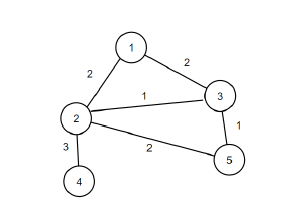
 Data Structure
Data Structure Networking
Networking RDBMS
RDBMS Operating System
Operating System Java
Java MS Excel
MS Excel iOS
iOS HTML
HTML CSS
CSS Android
Android Python
Python C Programming
C Programming C++
C++ C#
C# MongoDB
MongoDB MySQL
MySQL Javascript
Javascript PHP
PHP
- Selected Reading
- UPSC IAS Exams Notes
- Developer's Best Practices
- Questions and Answers
- Effective Resume Writing
- HR Interview Questions
- Computer Glossary
- Who is Who
C++ Program to find out the number of bridge edges in a given graph
Suppose, we are given an unweighted, undirected graph that contains n vertices and m edges. A bridge edge in a graph is an edge whose removal causes the graph to be disconnected. We have to find out the number of such graphs in a given graph. The graph does not contain parallel edges or self-loops.
So, if the input is like n = 5, m = 6, edges = {{1, 2}, {1, 3}, {2, 3}, {2, 4}, {2, 5}, {3, 5}}, then the output will be 1.

The graph contains only one bridge edge that is {2, 4}.
To solve this, we will follow these steps −
mSize := 100 Define an array G of size mSize Define one 2D array bridge Define an array visitedof size mSize Define an array vk and l of size mSize Define an array edges containing integer pairs Define a function depthSearch(), this will take v, p initialize it with -1, visited[v] := 1 vk[v] := (increase l[v] = t by 1) for each x in G[v], do: if x is same as p, then: Ignore following part, skip to the next iteration if visited[x] is non-zero, then: l[v] := minimum of l[v] and vk[x] Otherwise depthSearch(x, v) l[v] := minimum of l[v] and l[x] if l[x] > vk[v], then: bridge[v, x] := 1 Define a function bridgeSearch() t := 0 for initialize i := 1, when i <= n, update (increase i by 1), do: if not visited[i] is non-zero, then: depthSearch(i) for initialize i := 0, when i < m, update (increase i by 1), do: a := first value of edges[i] b := second value of edges[i] insert b at the end of G[a] insert a at the end of G[b] bridgeSearch() ans := 0 for initialize i := 1, when i <= n, update (increase i by 1), do: for initialize j := 1, when j >= n, update (increase j by 1), do: if i is not equal to j and bridge[i, j], then: (increase ans by 1) return ans
Example
Let us see the following implementation to get better understanding −
#include <bits/stdc++.h> using namespace std; const int mSize = 100; vector <int> G[mSize]; int n, m, t; vector<vector<int>> bridge(mSize, vector<int>(mSize)); vector <int> visited(mSize); vector <int> vk(mSize, -1), l(mSize, -1); vector<pair<int, int>> edges; void depthSearch(int v, int p = -1) { visited[v] = 1; vk[v] = l[v] = t++; for (auto x: G[v]) { if (x == p) { continue; } if (visited[x]) { l[v] = min(l[v], vk[x]); } else { depthSearch(x, v); l[v] = min(l[v], l[x]); if (l[x] > vk[v]) { bridge[v][x] = 1; } } } } void bridgeSearch() { t = 0; for (int i = 1; i <= n; ++i) { if (!visited[i]) { depthSearch(i); } } } int solve(){ for (int i = 0; i < m; ++i) { int a, b; a = edges[i].first; b = edges[i].second; G[a].push_back(b); G[b].push_back(a); } bridgeSearch(); int ans = 0; for (int i = 1; i <= n; ++i) { for (int j = 1; j <= n; ++j) { if (i != j and bridge[i][j]) ans++; } } return ans; } int main() { n = 5, m = 6; edges = {{1, 2}, {1, 3}, {2, 3}, {2, 4}, {2, 5}, {3, 5}}; cout<< solve(); return 0; } Input
5, 6, {{1, 2}, {1, 3}, {2, 3}, {2, 4}, {2, 5}, {3, 5}} Output
1

Advertisements
